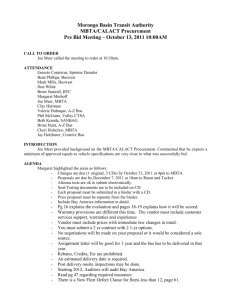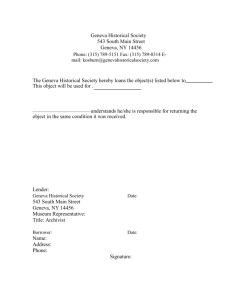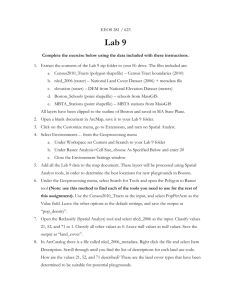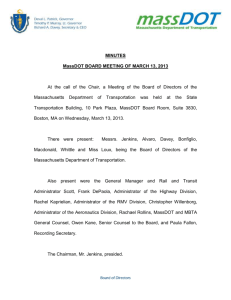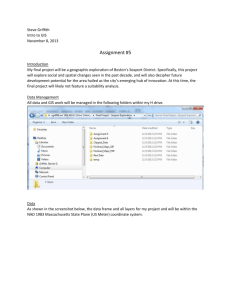Meeting Notes
advertisement
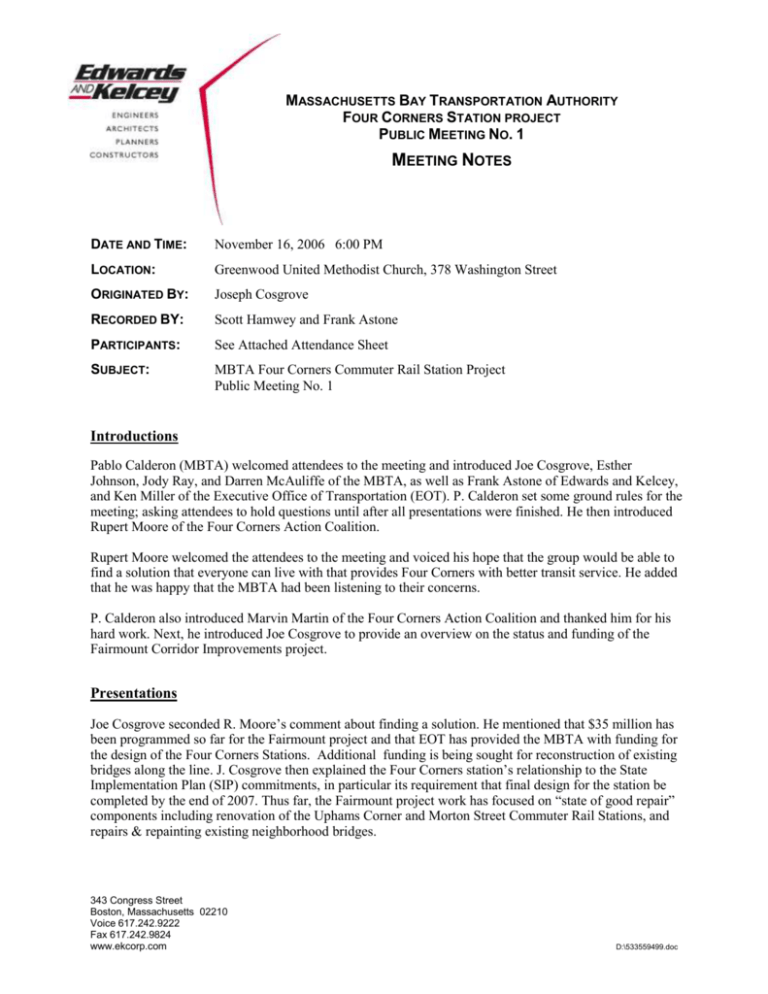
MASSACHUSETTS BAY TRANSPORTATION AUTHORITY FOUR CORNERS STATION PROJECT PUBLIC MEETING NO. 1 MEETING NOTES DATE AND TIME: November 16, 2006 6:00 PM LOCATION: Greenwood United Methodist Church, 378 Washington Street ORIGINATED BY: Joseph Cosgrove RECORDED BY: Scott Hamwey and Frank Astone PARTICIPANTS: See Attached Attendance Sheet SUBJECT: MBTA Four Corners Commuter Rail Station Project Public Meeting No. 1 Introductions Pablo Calderon (MBTA) welcomed attendees to the meeting and introduced Joe Cosgrove, Esther Johnson, Jody Ray, and Darren McAuliffe of the MBTA, as well as Frank Astone of Edwards and Kelcey, and Ken Miller of the Executive Office of Transportation (EOT). P. Calderon set some ground rules for the meeting; asking attendees to hold questions until after all presentations were finished. He then introduced Rupert Moore of the Four Corners Action Coalition. Rupert Moore welcomed the attendees to the meeting and voiced his hope that the group would be able to find a solution that everyone can live with that provides Four Corners with better transit service. He added that he was happy that the MBTA had been listening to their concerns. P. Calderon also introduced Marvin Martin of the Four Corners Action Coalition and thanked him for his hard work. Next, he introduced Joe Cosgrove to provide an overview on the status and funding of the Fairmount Corridor Improvements project. Presentations Joe Cosgrove seconded R. Moore’s comment about finding a solution. He mentioned that $35 million has been programmed so far for the Fairmount project and that EOT has provided the MBTA with funding for the design of the Four Corners Stations. Additional funding is being sought for reconstruction of existing bridges along the line. J. Cosgrove then explained the Four Corners station’s relationship to the State Implementation Plan (SIP) commitments, in particular its requirement that final design for the station be completed by the end of 2007. Thus far, the Fairmount project work has focused on “state of good repair” components including renovation of the Uphams Corner and Morton Street Commuter Rail Stations, and repairs & repainting existing neighborhood bridges. 343 Congress Street Boston, Massachusetts 02210 Voice 617.242.9222 Fax 617.242.9824 www.ekcorp.com D:\533559499.doc MBTA FOUR CORNERS STATION PROJECT MEETING NOTES – PUBLIC MEETING NOVEMBER 16, 2006 PAGE 2 OF 5 Esther Johnson added that Uphams Corner station would be complete by the end of 2006. She recommended that those who have not had a chance to see it do so. She mentioned that Morton Street station is 60% complete and the target completion date is the end of May 2007, and that the ongoing interlocking project will allow work to begin on the bridges. J. Cosgrove explained that in order to meet the December 31, 2007 target date for completion of a Four Corners station final design, they need to identify a location for the station as soon as possible. He said that issues that must be weighed for siting the station must include MBTA Railroad Operations requirements, Americans with Disabilities Act (ADA) regulations and neighborhood needs. He said EOT is exploring the long-term potential of using diesel multiple units (DMUs), and that the MBTA will pursue station design alternatives that would not preclude future changes and upgrades to the train service. He also identified the need for 760 foot long platforms to accommodate the MBTA’s longest trainsets, and high level platforms to satisfy the ADA requirement for level boarding. He then introduced Frank Astone to discuss the engineering challenges in meeting all of these requirements. Frank Astone presented plans and locator maps of various Four Corner station locations. He explained that a Four Corners Station would be a standard MBTA commuter rail station with full high level platforms, canopies, benches, signage, lighting, landscaping and accessible routes. He presented three potential station sites located at the following locations: South of Washington Street (the historic station location) Between Washington and Geneva Avenue with access from both streets North of Geneva Avenue F. Astone explained the drawbacks of each location, in particular the need for a high level platform to be located along a tangent or straight section of track in order to satisfy the ADA “gap” requirements between the platform and the train doors. This requirement presents significant challenges to the first two locations, which include the platform along curved sections of the track. The third site location, north of Geneva Avenue, would place the station on a straight section of track, but did not satisfy the community’s desire to serve the Four Corners area along Washington Street. He explained that they had developed a fourth alternative which split the platforms—one would be north of Geneva along the tangent stretch of track, and the other would be between Washington and Geneva. This was possible because of the ability to reduce the platform gap sufficiently by having a platform on the outside of the curved track. F. Astone presented a diagram to illustrate this concept. He explained that an additional benefit of this approach would be the creation of a new pedestrian connection between Washington Street and Geneva Avenue, reducing what is currently a roundabout route. Following the presentations, J. Cosgrove asked the audience for any questions. Questions Q: How long are the platforms in the station diagrams? A: 760 feet Q: Why can’t they build the station at the location it had been at previously (south of Washington)? A: That station existed before ADA requirements, and the platform was only a small strip of pavement on the ground. An attendee made a request that the representatives from the MBTA and the consultant identify the names of side streets when pointing to the maps. MBTA FOUR CORNERS STATION PROJECT MEETING NOTES – PUBLIC MEETING NOVEMBER 16, 2006 PAGE 3 OF 5 Q: Can these presentation maps be turned into handouts? They are hard to read from a distance. A: Pablo Calderon committed to sending them out by email or mail. City Councilor Charles Yancey addressed the group by saying that the process dates back to 1985. It has resulted in the return of stops at Uphams Corner and Morton Street. He said that his concern was to come up with a solution that serves the maximum number of people. He thanked everyone for being here. Q: How wide is the right of way on each side? A: The right of way is 80 feet wide. Q: Could the railroad tracks be straightened through the area of Washington Street? A: Frank Astone presented a map showing the impacts of straightening the track, including the need to take private land and houses, and the need to replace both the Washington Street and Geneva Avenue bridges. Q: Is the track curvature unique to Four Corners? A: No. However, the track geometry is always a major consideration in sighting any station. Q: Will the buses be rerouted to serve the station wherever it ends up? A: That is a good point and something that our service planning department will evaluate before a station would open. Q: Isn’t there technology available to bridge the gap between the train and platform? A: Not aware, but it would be better to locate any such device on a train than on a platform. Pablo Calderon said that they would look into it. Marvin Martin said that he didn’t think his group could support the staggered platform option. He reminded the group that the station was originally to have been at Harvard Street, but was eliminated because of the decision to add a Talbot Avenue station. He said that they then agreed to improve the accessibility to Geneva Avenue from the station, but that a station north of Geneva is not Four Corners. Q: What will be the fare structure? A: Commuter rail zone fares and with merging of Zone 1A and Zone 1B under the fare schedule going into effect January 1st it will cost $1.70 to ride to South Station from Morton Street, Uphams Corner; future Dorchester stations are likely to have pay the same rate. Q: Senator Hart’s Chief of Staff, Ms. Rosemary Powers, stated that the Senator’s office received a commitment from the previous MBTA General Manager, Mike Mulhern, for free transfers. The Senator would like confirmation on this committment. A: This is the current fare structure for pass holders. Q: Would it be possible to take advantage of the outside of the curve between Washington and Geneva by creating a new center platform for inbound trains? This would allow both platforms to be between Washington and Geneva. A: Frank Astone said that they could look into that. Q: Will the high ridership estimates for Four Corners from the feasibility study still be the same even if the station is moved to a worse location (north of Geneva)? A: Yes, the ridership estimates were conceptual and not tied to any specific station site. Q: Which bus route is busier—the 23 on Washington or the 19 on Geneva? A: The 23. Relieving overcrowding on the 23 is one of the benefits of this project. MBTA FOUR CORNERS STATION PROJECT MEETING NOTES – PUBLIC MEETING NOVEMBER 16, 2006 PAGE 4 OF 5 Q: How does the lack of Red Line access (for people along Washington Street as opposed to those further up Geneva) affect the decision making process? A: We know that the station needs to be as close to Washington as it can. Q: What is the distance from Washington Street to Geneva Avenue? A: About 800 feet. A gentleman commented that he lived on Norwell Street and that the speed limit for trains on the line was recently increased from 40 mph to 50 mph. He said the noise is much worse now and that he has complained to the MBTA. Pablo Calderon said that he had been the recipient of the complaints and that they had been forwarded to MBCR, the commuter rail contractor. Ms. Powers from Senator Hart’s office said that she would be happy to follow up on the complaint for the gentleman. Jody Ray explained that the speed limit on the line is actually 60 mph, but due to the curve at Washington Street there is a speed restriction there. The attendee asked why they needed to move trains at 2AM. P. Calderon replied that he would find out why they are moving trains that late. Councilor Yancey suggested that the issue was not only speed, but also noise, and that it was not only this individual who was being impacted. An attendee asked whether the new station would slow trains down and therefore reduce noise, to which the answer was yes. (Note: subsequent to the public meeting, representatives from MBCR and MBTA have been discussing this issue with Ms. Powers, and have agreed to lower the speed along the line through this area to 40 mph on a trial basis). Q: Councilor Yancey asked if there would be efforts made to purchase cleaner engines for this line to reduce pollution. A: That is a long term goal but very expensive to implement in the short term. Q: Why are the train horns on the line sounding for longer periods of time? A: There is a federal law requiring the horn to be sounded when there are people present on the track. With the ongoing construction on the line there has been a need to sound horns more frequently. Q: What will happen if there is no agreement on the station location? A: Joe Cosgrove said that the goal was to get consensus, and that they hope to have a decision over the winter, in February or March. Rupert Moore reminded the group that the goal was to get people into downtown without buses and a long trip, but that he would be hard pressed to support any of the proposed alternatives at this point. Pablo Calderon said that this was only the first meeting and that they would be back again. R. Moore said that the goal of this station is to serve Four Corners, and the way to do that is with a station at Washington Street. Another attendee raised the concern that they could disagree on locations until the end of 2007 and lose the money for the station. She reminded the group that it would take 45 minutes to go downtown after this meeting but that the trip will be reduced to 10 minutes with a new station. Q: Is the money there for a new station? A: Joe Cosgrove said that the money was there for design of a Four Corners Station and that any day they hope to get word on approval of regulatory changes formalizing the state commitment to enable the Fairmount Line Improvement project to progress. Ken Miller of EOT said that his understanding was that the Department of Environmental Protection (DEP) had filed the new State Implementation Plan (SIP) commitments today and that a legal commitment to build Four Corners station was expected to be a part of that filing. Q: If the design for Four Corners was completed before December 31, 2007, would the construction be able to begin early? MBTA FOUR CORNERS STATION PROJECT MEETING NOTES – PUBLIC MEETING NOVEMBER 16, 2006 PAGE 5 OF 5 A: Joe Cosgrove said that once the commitments are in place, there will be timelines established for each project and that EOT will work with the Executive Office of Administration and Finance to release funds. Ken Miller added that DEP has filed the SIP with EPA, but that EPA still needs to review it. Q: How long a walk would it be from Washington Street to Geneva Avenue? A: F. Astone responded that with an average walking speed of 4 feet per second, it would take approximately 3½ minutes to walk 800 foot distance between Washington and Geneva. Q: We need to pay attention to the process. Other projects are out there. I’m hearing the Green Line in Somerville mentioned along with the Fairmont Line. Is there a chance that they will have to decide to do only one or the other of these? A: This is why EOT redid the SIP—to realign the projects with what could be built and to prioritize. Q: Will this project be impacted by Governor Romney’s recent $400 million in cuts? A: No. Q: Each of the locations presented tonight probably comes with a different price tag. Will we run into funding problems depending on which site we select? A: We hope not. Q: What about the issue of parking on side streets? A: After a location is selected, the MBTA would like to discuss this issue with the community. Q: Is it possible that the station won’t be funded? A: Never say never, but this is a priority that we expect to be funded in the short term. A representative from Four Corners Main Streets commented that easy access is essential to building commercial districts. She was concerned that splitting the inbound and outbound platform locations would dampen those economic benefits for Washington Street businesses from foot traffic related to the station. Q: Couldn’t the MBTA use a modified version of the plate that is currently used on commuter rail trains to cover the stairs at high level platform stations to bridge the gap. A: Jody Ray said that this was called a “bridge plate” and that the MBTA would look into this option. Q: How big will the gap be? A: 8 to 10 inches. Q: Is the end of 2007 deadline calendar year or fiscal year? A: Calendar year. Wrap-up Pablo Calderon thanked everyone for their time in attending the meeting. He said that they would be meeting again soon after the MBTA had a chance to respond to some of their comments and suggestions. A request was made to add the meeting notes from this meeting to the mailing of handout versions of the presentation maps, to which P. Calderon agreed. He also provided the group with the MBTA project hotline, 617.222.6757 and said that information was also available on the internet. The meeting adjourned at 8:30 PM
